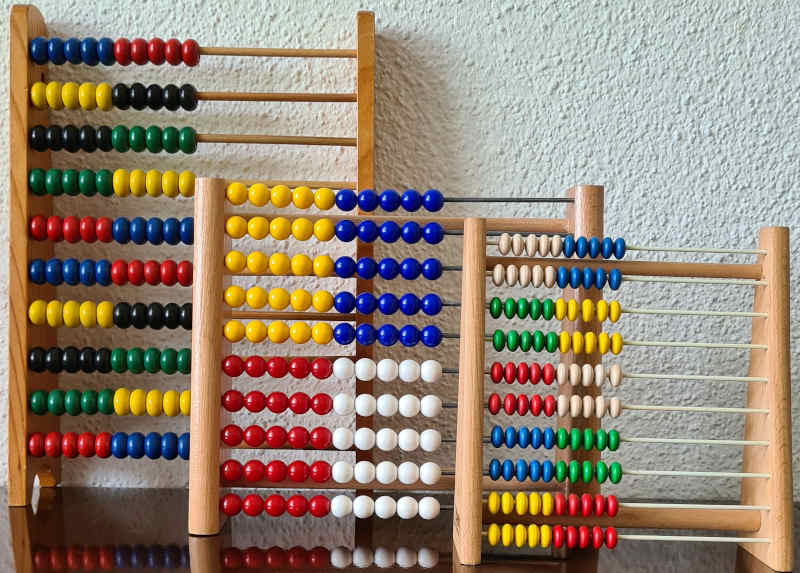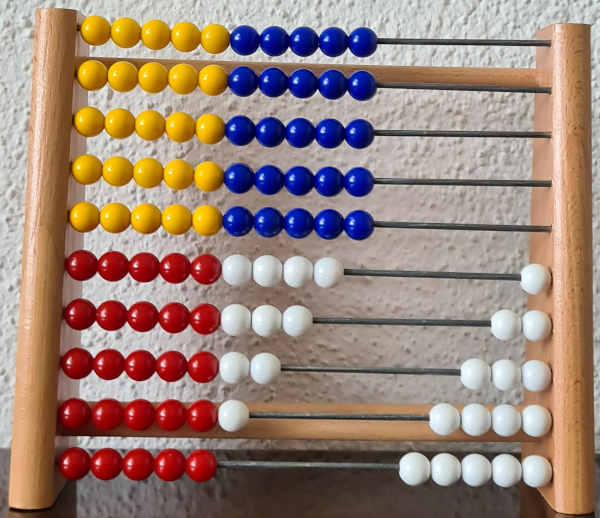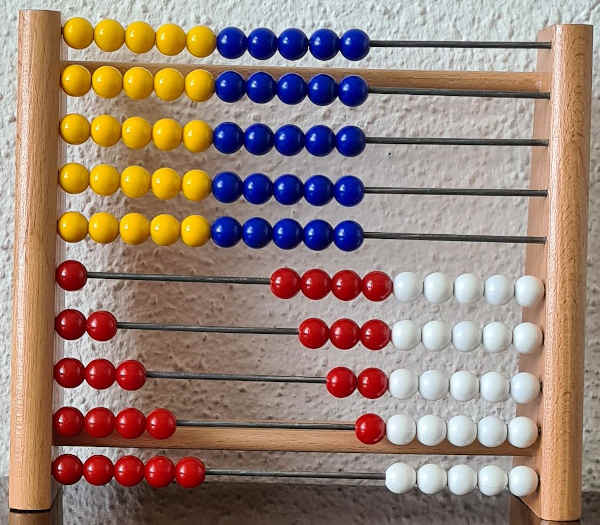
In flea markets, the abacus (see fig. 1) is omnipresent. Nevertheless, one hardly finds Western Europeans who know how the bead frame works. Decades ago, such devices were frequent in our schoolrooms. They were used to teach children how to calculate.
In the Technisches Museum Wien (Vienna), there is a hands-on model. Observations show that visitors have trouble as soon as too few beads are available in a row for the calculation. Similar experiences are also made during live demonstrations.
The millennia-old bead frame comes in many forms, e.g., as Chinese, Japanese, or Russian abacus. In China, these aids can still be found from time to time, however they have largely been replaced by the smartphone. From the Russian counting frame, the school abacus was developed. It is based on the decimal system. These arithmetical frames are digital devices.
Fig. 1: Three bead frames, each in the zero position.
Credit: Bruderer Informatik, CH-9401 Rorschach, Switzerland
The abacus is suitable for all four basic arithmetic operations
With the calculating board, all four basic arithmetic operations—addition, subtraction, multiplication, and division—can be performed. Multiplication is a repeated addition; division, a successive subtraction. Trained people can solve arithmetical problems very quickly with the beads. This is shown in a video of the Deutsches Museum, Munich.
In the zero position, all the beads are either on the left or the right side. When calculating, it is preferable to start with the units, tens, and hundreds.
Units: tens, hundreds, thousands.
On the lowest rod are the units, on the second-lowest rod the tens, on the third-lowest rod the hundreds, and so on. Each rod contains 10 beads. To make handling easier, five beads in each row have a different color.
Number representation
In the following example, all beads are on the left side in the basic position. The values 12,345 (see Fig. 2) and 98,765 (see Fig. 3) are displayed as follows:
Fig. 2: The counting frame shows the number 12,345. On the lowest rod of the decimal calculator are the units, above them the tens, etc.
Credit: Bruderer Informatik, CH-9401 Rorschach, Switzerland
Fig. 3: The value 98,765 is shown on the counting frame.
On this digital calculator, 10-digit numbers, i.e. values up to 9 billion (9 999 999 999), can be displayed.
Credit: Bruderer Informatik, CH-9401 Rorschach, Switzerland
A few simple examples will explain the procedure. There are various methods.
Addition: 37 + 8 = ?
All beads are on the left side. First, you move 3 tens beads and 7 units beads to the right. But for adding the value 8, only 3 units beads are available. Therefore, you move 1 tens bead to the right and remove 2 units beads: 37 + 8 = 37 + (10-2) = 45.
Or:
All beads are on the right side. First, 3 tens beads and 7 units beads are moved to the left. But for adding the value 8, only 3 units beads are available. Therefore, one moves 1 tens bead to the left and removes 2 units beads: 37 + 8 = 37 + (10-2) = 45.
Subtraction: 456-78 = ?
All beads are on the left side. You move 6 units beads, 5 tens beads and 4 hundreds beads to the right side. To subtract the number 8, move 1 tens bead to the left and add 2 units beads (-8=-10+2). The counting frame shows the value 448. To subtract the value 70, move 1 hundreds bead to the left and 3 tens beads to the right (-70=-100+30). This gives the number 378.
Or:
All beads are on the left side. You move 6 units beads, 5 tens beads and 4 hundreds beads to the right side. To subtract the number 70 you move 1 hundreds bead to the left and add 3 tens beads (-70=-100+30). The counting frame shows the value 386. To subtract the value 8, move 1 tens bead to the left and 2 units beads to the right (-8=-10+2). This gives the number 378.
Multiplication: 4 x 57 = ?
All beads are on the left side. First the value 57 is set. The number 57 is added 3 times: 1 tens bead is added, and 3 units beads are removed (+10-3=+7). Now 1 hundreds bead is moved to the right, 5 tens beads come to the left (+100-50=+50). The counting frame shows the value 114. One tens bead is moved to the right, 3 units beads are removed (+10-3=+7). Five tens beads are added (+50). The abacus shows the value 171. Seven units beads and 1 hundreds bead are moved to the right, 5 tens beads are moved to the left (+7+100-50 =57). According to the counting frame, the result is 228.
Division: 1,737 : 579 = ?
All beads are on the left side. The number 579 is subtracted as often as possible. First the number 1,737 (dividend) is set. Now 5 hundreds beads are moved to the left (-500). Since only 3 tens beads are available, 1 hundreds bead goes to the left, 3 tens beads are moved to the right (-100+30=-70). One tens bead goes to the left, 1 units bead is moved to the right (-10+1=-9). The device shows the value 1158.
Now 1 thousands bead goes to the left, 5 hundreds beads go to the right (-1000+500=-500). One hundreds bead moves to the left, 3 tens beads move to the right (-100+30=-70). Now 1 tens bead is subtracted, 1 units bead is added (-10+1=-9). The frame now shows the number 579.
Finally, 5 hundreds beads, 7 tens beads ,and 9 units beads are moved to the left side (-500-70-9=-579), and the frame shows the value 0. We had to subtract the number 579 (divisor) 3 times, so the result (quotient) is 3.
How did the Romans calculate?
Dealing with the Roman number system is difficult. Great buildings show that the Romans were good calculators nevertheless, because calculations were done with the abacus. Roman numerals were only used to represent the numbers (initial values, intermediate and final results). Only a few Roman hand abaci have survived. They are located in Aosta, Paris and Rome. They do not use beads, but buttons that are moved in vertical grooves. For this purpose, the devices are placed on a table. The numbers 0 to 9 are represented by 4 units buttons and 1 fives button, the numbers 10 to 100 by 4 tens buttons and 1 fifties button, etc. The Romans could therefore represent the number 0, but did not have the numeral 0.
Concluding remarks
Basically, you don’t have to calculate with the bead frame, you just have to count. Therefore, one speaks also of the counting frame.
References
Barnard, Francis Pierrepont: The casting-counter and the counting-board. A chapter in the history of numismatics and early arithmetic, Oxford University Press, Oxford 1916, 358 pages, 63 plates, https://amzn.to/35qEddC
Bruderer, Herbert: Meilensteine der Rechentechnik, De Gruyter Oldenbourg, Berlin/Boston, 3rd edition 2020, volume 1, 971 pages, 577 illustrations, 114 tables, https://www.degruyter.com/view/title/567028?rskey=xoRERF&result=7
Bruderer, Herbert: Meilensteine der Rechentechnik, De Gruyter Oldenbourg, Berlin/Boston, 3rd edition 2020, volume 2, 1055 pages, 138 illustrations, 37 tables, https://www.degruyter.com/view/title/567221?rskey=A8Y4Gb&result=4
Bruderer, Herbert: Milestones in Analog and Digital Computing, Springer Nature Switzerland AG, Cham, 3rd edition 2020, 2 volumes, 2075 pages, 715 illustrations, 151 tables, https://www.springer.com/de/book/9783030409739
Dilson, Jesse: The abacus. A pocket computer, St. Martin’s Press, New York 1968, 143 pages, https://amzn.to/35mVPHy
Kojima, Takashi: The Japanese abacus. Its use and theory, Charles E. Tuttle Company, Rutland, Vermont, Tokyo 1969, 102 pages
Moon, Parry: The abacus. Its history; its design; its possibilities in the modern world, Gordon and Breach Science Publishers, Inc., New York 1971, 186 pages.
Pullan, J. M.: The history of the abacus, Hutchinson & Co (Publishers) Ltd, London, Melbourne etc. 1968, 140 pages.
Yoshino, Y.: The Japanese abacus explained, Dover Publications, Inc., New York 1963, 253 pages.
Herbert Bruderer is a retired lecturer in didactics of computer science at ETH Zurich. More recently, he has been an historian of technology. bruderer@retired.ethz.ch, herbert.bruderer@bluewin.






Join the Discussion (0)
Become a Member or Sign In to Post a Comment